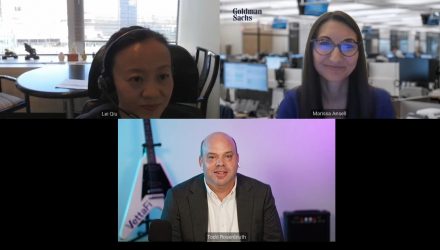There is a plethora of AI-related investment opportunities, with the winners and losers yet to be determined.
With AI still in the early innings, active managers are able to capture unique opportunities that passive funds might miss. Passive funds are inherently backward looking, often rebalancing quarterly or semiannually, and thus reflecting moves that have already happened.
“Thematic investing is really focusing on identifying some of the transformational changes across industries and across society,” Lei Qiu, portfolio manager, disruptive innovation equities, for AB, said during VettaFi’s AI Symposium on August 30.
“Benchmarks tend to be backward looking. It rewards the proven winners, and it doesn’t necessarily capture the moment of change when the big ideas come along. So that’s where active management comes in,” Qiu added.
Importantly, Qiu said, identifying a big theme does not necessarily translate into creating a portfolio that will generate superior returns. While thematic investing can help investors generate superior returns over time, it takes an active manager to dig through the themes to determine which opportunities are mature enough, with a large enough total addressable market.
When selecting securities, Qiu said it’s important to consider company management. This level of scrutiny is something unique to active management; something that benchmarks can’t do.
How Active Management Can Add Value in AI Investing
Marissa Ansell, head of thematic client portfolio management for Goldman Sachs Asset Management, said the newness of AI underscores the importance for active management. Ansell said she expects the AI landscape to change dramatically in the next few years as the industry matures.
“We do think that AI is certainly the biggest, most transformative change that we’ve seen in tech in the last 20 plus years. And I think that AI is likely to completely change how we live and how we work and interact, and obviously drive productivity gains for enterprises.”
However, Ansell said, there is a lot of hype in the space that shouldn’t be confused good opportunities. It will take a skilled manager to weed out the hype.
“For some companies, it will be just hype without a lot of substance. But for others, I think that AI will be very real, very durable and have a pretty meaningful impact on their growth and earnings,” Ansell said. “So for us as active investors, that’s really our job to try and identify which companies are which. Try and identify the ones that are going to be the winners over the long term.”
Active Managers Can Get Ahead of Benchmarks
Additionally, as active managers, Ansell said the firm is always trying to anticipate market movements.
“We’re trying to invest in stocks before expectations are fully priced in,” Ansell said. “Since we’re managing our portfolios in real time, we can be very nimble. We can change our positions as news flow emerges. We’re hunting for lesser-known ideas, often in the small cap space, even recent IPOs which can present great Alpha opportunities. We also pay a tremendous amount of attention to valuations.”
Ansell said she thinks about AI beneficiaries in three main buckets: the enablers, which are the companies producing the necessary infrastructure to support AI; the data layer, which includes sandboxing and cybersecurity; and the applications, which is any industry that will use AI to improve their products and services.
Getting Exposure to AI With FWD
In the AB Disruptors ETF (FWD), Qiu said she thinks of it as part of FWD’s thematic play on cloud infrastructure.
“At this stage, we tend to play the enablers, and that includes semiconductor names such as Nvidia (NVDA),” Qiu said. “We think of it more broadly as optical interconnect tools and testers that will be needed for high bandwidth memory and then also the tools needed for advanced packaging. So there are different tools that we will need today to make an AI a reality.”
Qiu also pointed to the energy intensiveness of AI. How the data centers are powered and cooled is another investment opportunity to consider, even at the current early stage.
Qiu reiterated that it’s too early to determine which companies will be the winners. “As active manager, you really need to do the work to figure out if it’s too early to call.”
Using Goldman Sachs Asset Management ETFs for AI Exposure
Ansell said Goldman Sachs Asset Management has three actively managed ETFs that all provide real exposure to AI: the Goldman Sachs Future Tech Leaders Equity ETF (GTEK), the Goldman Sachs Future Health Care Equity ETF (GDOC), and the Goldman Sachs Future Consumer Equity ETF (GBUY).
GTEK invests in global innovative tech companies. It has a focus on small- and mid-cap companies that most investors are underexposed to, Ansell said. This makes it a great complement to the U.S. mega-cap tech stocks that most investors already have in abundance in their portfolios. About a third of GTEK by weight is invested in companies Goldman Sachs Asset Management thinks are leaders or direct beneficiaries of AI.
GDOC invests in innovative healthcare companies across the fields of genomics, precision medicine, tech enabled procedures, and digital healthcare. About a third of the portfolio is invested in companies that are leveraging AI and machine learning. GDOC is a way to get exposure to lesser-known AI beneficiaries that may be underappreciated by the market.
GBUY invests in companies that Goldman Sachs Asset Management believes are aligned with the unique consumption preferences of the millennial and Gen Z consumers.
“Younger consumers really leverage technology in everything that they do. They also have quite unique lifestyles and values and different preferences to older consumers,” Ansell said. “It’s another great way to play AI, but in a very thoughtful and differentiated way.”
To view this session and others from the AI Symposium, register for the on-demand replay.
For more news, information, and analysis, visit the Artificial Intelligence Channel.

